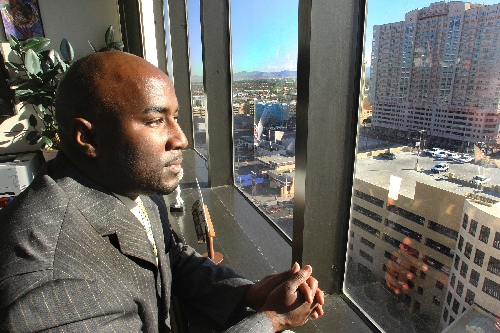Symphony Park, Historic Westside School project among expected boosts to Ward 5

Construction equipment chugs along on the 61-acre Symphony Park development, crafting an area planned in the next few years to house Las Vegas’ most important civic, cultural and medical facilities.
Another economic push downtown is expected a few blocks away, involving online retail giant Zappos.com and its plans to move into the current Las Vegas City Hall, 400 Stewart Ave. City officials are expected to move to another downtown location in 2012.
It could be a major economic turning point for Ward 5, which also claims the struggling historic Westside. It seems that south of U.S. Highway 95, redevelopment projects in the ward are completed quickly with the full support of city officials, while projects north of U.S. 95 appear to take more time and struggle for funding, Councilman Ricki Y. Barlow said.
That’s because redevelopment boundaries dictated where money could be legally used for certain projects, he said. Years ago, residents in that area feared a city eminent domain clause that left a doughnut hole in the center of West Las Vegas. Commercial properties reaped the benefits after the residential component was eliminated from the redevelopment overlay, Barlow said.
In his office atop City Hall, Barlow reflected on the many facets of his ward, a place he has lived since 2006, and how he plans to jump-start the community’s economy.
“What we’re trying to do is create an opportunity to diversify our economic base,” Barlow said. “Symphony Park is a great master development and has a lot of potential for the entire community.”
He listed anchor properties the Cleveland Clinic Lou Ruvo Center for Brain Health, 888 W. Bonneville Ave., and The Smith Center as key victories for the city.
About 11 percent of the ward’s 94,000 residents have a college education. More than 18 percent of the population lives below the poverty level, and about 10 percent are unemployed, according to last year’s city statistics.
Long ago, the area was a place where blacks sought refuge from segregation on the Strip. The famed but now crumbling New Town Tavern, 600 Jackson Ave., brought much-needed business to the area. Now, the former community anchor that opened in 1955 sits empty — a victim of the recession and shut down by city code violations.
Other redevelopment projects are in the works, including a renovation of the Historic Westside School. Plans to restore the campus, which was built in 1923 and shut down in 1967, could transform it into a financial gateway with mixed-use development attracting business to one of the city’s most economically depressed areas.
But at this point, it is unclear how much money it would cost to develop the site. However, financial resources — in the form of bonds, redevelopment dollars and other funds — have become available to move the project forward, Barlow said. The goal is to create a development similar to Town Square Las Vegas or The District at Green Valley Ranch. The project requires unique funding in that federal community development block grants are used for one part of the campus while redevelopment dollars must be used on the other.
The F Street corridor used to be that gateway into the heart of government offices, including City Hall, until it was shut down in September 2008 as part of the $240 million Interstate 15 north widening project. The project spurred some residents to protest. The road is slated to reopen in late 2013, shortly after Symphony Park opens. Construction is scheduled to begin in mid-2012.
Barlow said the project is facing some financial challenges that could delay the opening. But he is hopeful the state’s Department of Transportation might fill in the estimated $3 million to $5 million budget gap.
The project also recently raised unexpected concerns from Ward 3 Las Vegas City Councilman Bob Coffin and community activist Katie Duncan, according to a Sept. 21 Las Vegas Review-Journal story.
During a discussion that day with the city’s redevelopment agency, Coffin questioned the cost of the project while Duncan said the street’s closure was having a positive impact on the neighborhood, including a reduction in traffic and the presence of homeless people. Duncan had initially supported F Street’s reopening. Barlow said it was too late to reverse the project and that Duncan did not represent a consensus among residents, the Review-Journal reported.
Some residents have said the F Street closure was racially motivated and an attempt to segregate the community from downtown.
Trish Geran, who chairs the F Street Coalition and has been a vocal critic of the street closure, said she’s happy with the project’s progress.
“I know that some people say, ‘You open up the street, and then what?’ ” she said. “It’s a beginning. It’s better than nothing. The Historic Westside School is going really well because opening the street sparked a great interest. The spark became even greater when (developers) saw the community does want more for this area. The west side is gaining momentum.”
Contact reporter Kristi Jourdan at kjourdan@
reviewjournal.com or 455-4519.